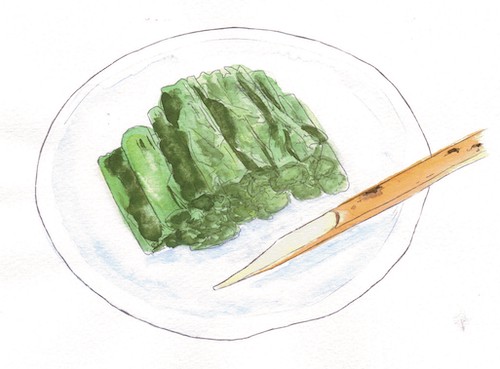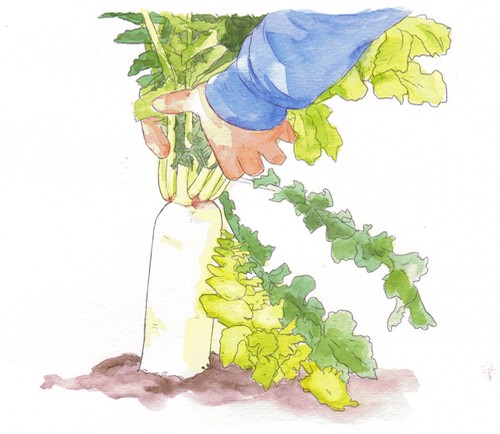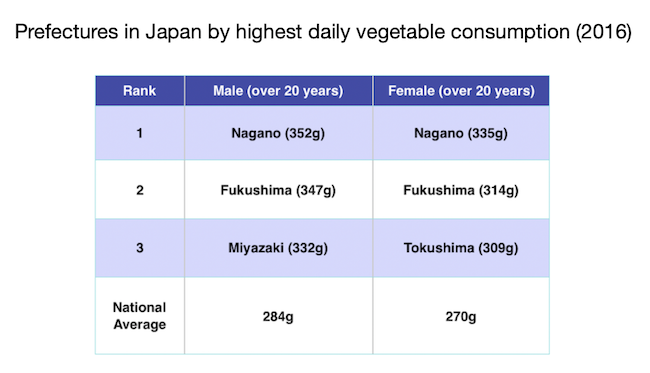
Trade shaming for moderation
If you type into the Google search bar, “What is the healthiest prefecture in Japan?” one spot comes out on top in big, bold letters: Nagano Prefecture.
Some people might be surprised, expecting Okinawa to be the healthiest prefecture. The Okinawan diet is famous around the world and its people are known for living long, healthy lives. While this is true, especially among traditional Okinawan communities that continue to adhere to old ways of living, Nagano has surpassed it.
In 2015, the people of Nagano had a life expectancy of 84.72 (81.75 for men, 87.68 for women), an average that put it at the top in terms of longevity in the country (Ministry of Health, Labour and Welfare). The prefecture also has the lowest rate of deaths due to illnesses such as heart disease, liver disease, cancer, and pneumonia in the country.
So why don’t we hear about Nagano that often? Until quite recently, Nagano was among the unhealthiest prefectures in the country. They had the highest rates of salt consumption, and, correspondingly, notoriously high rates of deaths due to strokes and heart attacks.
Why Nagano was so salty
Unlike coastal prefectures, Nagano doesn’t have access to the sea and historically had a very difficult time farming enough food to make it through winters. To survive, they relied heavily on pickled foods to conserve whatever they were able to cultivate and added salt to a lot of their foods for preservation.
With a local culture so heavily dependent on salted foods, even with the arrival of modern agriculture and food preservation technology, it was very difficult for the people of Nagano to shift their diet. They had a culture of drinking entire bowls of salty noodle broths and eating large servings of briny nozawana pickles with every meal. But with these daily eating habits, the health of the prefecture’s people was suffering.

How Nagano saved itself
Beginning at the local level, community leaders began to promote campaigns that encouraged less salt consumption. Among their recommendations were eating fewer pickles rather than an entire bowlful, and to drink up only half of the soup bowl when enjoying noodles.
They also promoted their prefecture’s local agriculture as delicious and best in quality, and public officials began to organize public demonstrations at supermarkets to teach passersby ways to cook with fresh vegetables. Over time, households began to cook with fresh vegetables more often. Now, Nagano regularly ranks as on average №1 in per capita vegetable consumption in Japan. In fact, the campaigns were so successful that Nagano is now known for its fresh vegetables and juicy ripe fruits, and tourists from all over visit the prefecture in anticipation of fresh, healthy food.
What differentiates the region’s strategy
Notice that campaign recommendations were not to eliminate eating pickles, or to cut out enjoying noodle soups altogether. Local leaders understood how salted pickles or soba play a cultural role.
Rather than disciplining their citizens to eliminate salted foods and shaming them for having too much of it, the focus was on ways to still enjoy their local foods, but in ways that could complement a healthy lifestyle.
Instead of teaching people to cut out “unhealthy” foods, community leaders were able to accomplish successful behavior changes as a result of the framing of the campaigns: Rather than disciplining citizens to eliminate salted foods and shaming them for having too much of it, the focus was on ways to still enjoy their local foods, but in ways that could complement a healthy lifestyle. They encouraged eating pickles and salty noodle broths, but to only have it in moderation, and doubled down on efforts to promote fresh, seasonal vegetables from the area, and taught communities how to cook with it
Lessons from Nagano
Today, Nagano is one of the healthiest prefectures in the country: They regularly rank top in longevity, the number of active elderly over the age of 65, and have low medical bills for individuals over the age of 75, about $1,000 less per person than the national average. Their efforts in preventative medicine now save the prefecture millions of yen every year in healthcare costs, and this tax money can be reallocated to building new sidewalks for walking, parks, and public welfare programs to improve the quality of life.
I believe that you should be demanding government-level intervention for better healthcare if it doesn’t exist in your own country, and to improve public school systems for nutrition education and accessibility to fresh food.
But lessons from Nagano can also be applied to the way you approach health at home: Instead of relying on willpower and strict dieting, emphasize moderation with the foods you love, and add fresh fruits and vegetables that you enjoy. The foods we love and enjoy can coexist with the foods that nourish, heal, and build our bodies — this was the key idea in getting Nagano to change for the better.

